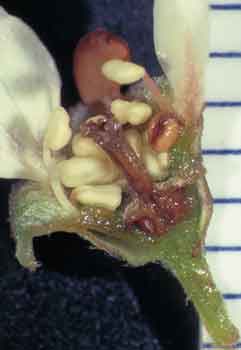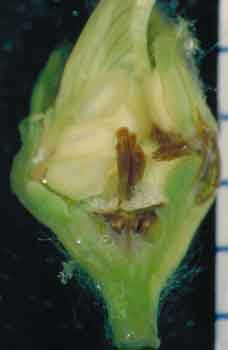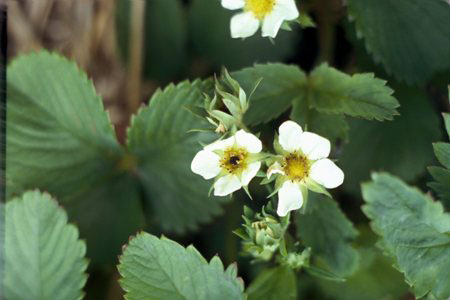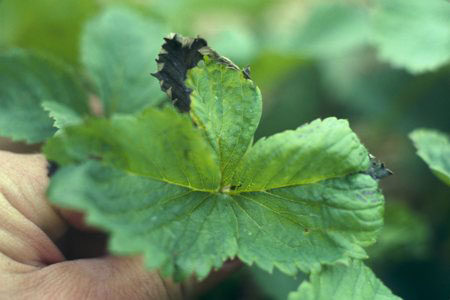Frost Damage and Protection in Strawberry and Saskatoon Orchards
With the recent frost in some areas of the province, saskatoon and strawberries flowers were at risk of damage. Most saskatoon orchards are at balloon or full flower phase so they may be at the greatest risk of frost damage, while for strawberries flowering was just starting (5% flowering or less).
The amount of damage to the flower tissue depends on many factors such as length of frost event, lowest temperature achieved, soil temperature/ moisture levels (heat release from the soil by conductivity) and precipitation (snow/ rain) occurring during frost event (may help protect plant similar to irrigation method).
Keep in mind that temperatures can be two to three degrees cooler than temperatures reported by weather stations, which are taken at shoulder level. Therefore, thermometers or electronic temperature alarms should be located in low spots where frost would usually occur first.
Saskatoons Frost Tolerance and Injury Symptoms
Saskatoon flowers and newly-set fruit are susceptible to damage with frosts at -2.2ºC or lower. Below this temperature actively growing plant tissues (e.g. flower buds) are killed or damaged. This damage may be visible within one hour to a couple days after the frost. Symptoms of frost damage are not always visible, but look for slight browning of internal flower tissue and slight browning of flower petals.
Saskatoon flower buds can tolerate lower frost temperatures depending on its stage of development. Detailed frost tolerance research on apples, which is in the same family, indicate the following: tight bud flower stage can tolerate -8ºC, first pink -6ºC, full pink -4.6ºC, first bloom -4 ºC, full bloom -4.7 and post bloom -3ºC. Note: These temperatures would have to be present for 30 minutes with an expected kill rate of 90%.
Photos of frost damaged saskatoon flowers.


Photo credit: Richard St.Pierre
Strawberries Frost Tolerance and Injury Symptoms
Strawberry flower buds and fruit are susceptible to frost injury any time after bud break (-1ºC or lower). Frost damages the center of the flower with the center turning black while the petals and leaves appear uninjured. The blackening occurs within a few hours to one day after the frost. Frost can also damage the developing fruit, deforming the berries. Frost injury rarely causes complete crop loss because the strawberry plant produces flowers over a two to three week period. The first flowers to open are the largest and face the greatest risk of frost injury. Closed buds are also sensitive to frost damage. Frost losses can range from 20 to 80% depending on the temperature and the duration of the frost, the cultivar, vigor, stage of development and the weather preceding the frost. Strawberry flower buds can tolerate lower frost temperatures depending on its stage of development. For example tight bud flower stage can tolerate -5ºC, tight with white petals -2.2ºC, full bloom -1ºC, past full bloom and immature fruit can tolerate -2.2ºC. Note: These temperatures would have to be present for 30 minutes with an expected kill rate of 90%.
Frost Protection Measures
Most strawberry fields in the past have been irrigated by solid set irrigation which allows for quick conversion to a frost protection system. However with the increased use of drip tape in strawberry fields and all saskatoon orchards this method is not available. Mild frost damage can be controlled by management practices other than solid set irrigation. These include not tilling the soil during the frost risk period in early spring. Untilled soil acts as a heat sink during the day and this heat is released during the night to protect the plants. Irrigation prior to a frost will provide an increased heat release from the soil by conductivity. The use of polyethylene covers will reduce damage to flowers caused by light frosts and cold winds. Long term measures include thinning out shelterbelts surrounding the orchard to allow for more air flow and reduce the problem of frost pockets on the site.
Saskatoon orchards may have to consider using frost control measures practiced by other tree fruit orchards in Canada in order to protect their yield and investment. Such measures include use of wind machines, outdoor heaters/ fires and artificial fogs. These measures are more effective with radiation frost than advection frosts (see frost type definitions below). However the cost of setting up such systems must be balanced with value of the crop. In vineyards where crops are very valuable, costly measures to protect a crop can be justified.
The Frost Control Principle and Frost Injury Levels
As water freezes, heat is released, keeping the plant parts above the freezing point. This frost control method is effective down to about – 6.6°C. The key to utilizing this principle successfully is to leave the irrigation system operating until after sunrise to ensure that the ice will melt.
A temperature of – 1°C at the plant level may cause slight injury to open flowers. A medium injury to open flowers can be expected at – 2°C. Temperatures below – 3°C at the plant level will cause severe injury to buds and developing berries.
Key tools for frost control include an automatic thermal alarm, several probe sensors or thermistors and several accurate thermometers. The thermistors are placed in the flower buds of two random plants, preferably with one plant located in a low area of the field and the other beyond the frost protection system. The thermometers should be placed at the thermistor locations as a double check. A comparison of the readings at the two sites will help determine when to stop the irrigation system. These are the key steps for frost control:
- Start the sprinklers just before the air temperature at ground level reaches 0°C, use nozzles designed for frost protection (low output rate, metal).
- Apply 2.5 to 3 mm/h. (1/10 to 1/8 in./h.). At this rate 655 to 822 L/ha (60 to 75 gal./acre) of water is applied.
- Do not stop when ice begins to form on the plants.
- Operating time needed to control frost varies from three to fifteen hours, but usually takes eight to ten hours. A slight breeze or cloud cover during the night may temporarily raise the temperature about the freezing point, but the temperature can drop below freezing just as quickly if conditions change.
- Ice may form anywhere from 1.6 to 12 mm thick (1/16 to ½ in.) depending on the intensity and duration of the frost. This does not seem to injure low growing strawberry plants.
- Leave sprinklers on until the temperature increases enough to start melting the ice that has formed.

Photo 1: The strawberry blossom on the left is frost injured. The pistils (female flower parts) are darkened and killed, while the stamens (male parts) and the rest of the flower show no injury. The strawberry blossom on the right has not been frost injured.

Photo 2: Strawberry leaf frost damaged, with black curled leaf edges.
Definitions
Radiation Frost - Clear; calm; inversion; temperature greater than 0 °C during day
Advection Frost- Windy; no inversion; temperature can be less than 0 °C during day
References
St. Pierre, R. Growing Saskatoons: A Manual for Orchardists. 1997, University of Saskatchewan.
Snyder, R. and Paulo de Melo-Abreu, J. Frost Protection: fundamentals, practice, and economics. Vol. 1. 2005, Food and Agriculture Organization of the United Nations. http://www.fao.org/docrep/008/y7223e/y7223e00.HTM
Commercial Strawberry Production on the Prairies. AAFRD, SAFRR and MAFRI. 2005. Order information
